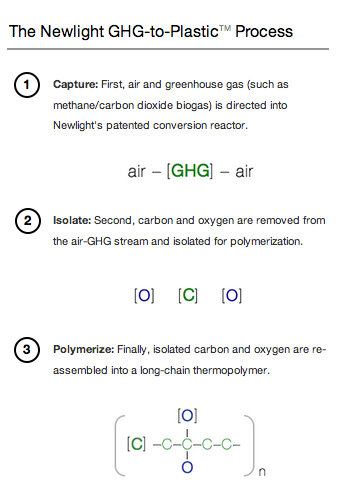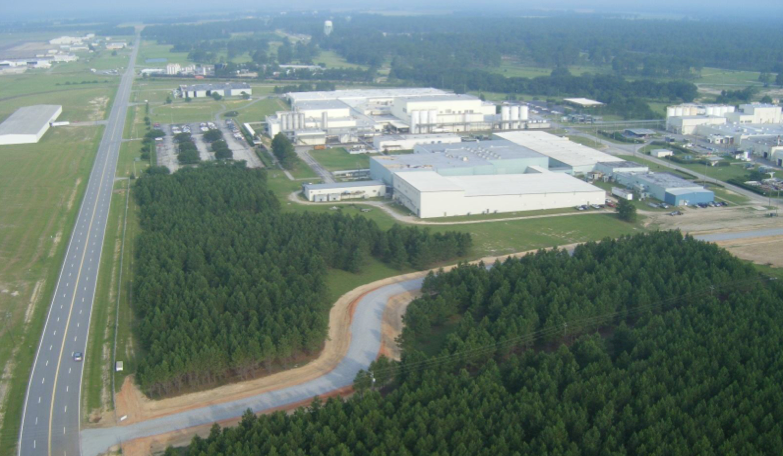I have two posts that keeps accumulating virtual dusts…this one and the one about oleochemicals…
Since I am in the bioplastic mode again (thanks to recent news about polybutylene succinate or PBS), let me see what we can do with this one about polyhydroxyalkanoate (PHA) since there had been several news that came out about in the past few weeks.
One is this company called Newlight Technologies which has been operating under stealth mode since its inception in 2003. Newlight has developed a resin functionalization technology that enables the company to produce PHA-based plastics that reportedly can match or exceed the performance of commodity plastics using using air and greenhouse gases, such as methane and carbon dioxide for feedstock.
Reminds me of LanzaTech technology except LanzaTech is not focusing on PHA-based resins.
Just for a background, PHAs are semi-crystalline thermoplastic polyesters that are fully biodegradable in anaerobic and aerobic conditions (copying this verbatim from an industry source).
Newlight Technologies said it has invented, patented, and commercialized a game-changing carbon capture and plastics manufacturing technology. The most important thing to note is that the company is already operating on a large-scale, continuous basis, and is in fact already selling its plastics to customers with applications ranging from furniture parts to storage containers to packaging films.
Capabilities of Newlight’s advanced-generation line include the ability to produce the company’s most advanced-performance grade resins, including resins that can supplant otherwise non-sustainable grades of polypropylene, polyethylene, ABS, and TPU.
The company said it has developed a biocatalyst that produces polymers at efficiencies that are over 500% greater than those of previous biocatalysts
Here’s an advert video for more about their technology:
[youtube http://www.youtube.com/watch?v=LwoqJj2brLQ]
Newlight Technologies recently announced that it has scaled up its capacity and is now producing at a rate of more than 100,000 lbs/year at its Southern California facility.
The company said it is able to produce advanced-performance grade resins as alternative to grades of petroleum-based polypropylene, polyethylene, ABS, and TPU. With key performance and price benchmarks achieved over multiple years of operations, NewLight Technologies is now preparing for significant near-term capacity expansion, with progress underway to add new multi-million pound per year capacity within the coming quarters.
“We have been working to bring our technology to commodity scale since 2003, so it is exciting for us as our growth curve accelerates,” said Newlight CTO, Kenton Kimmel. “A combination of key breakthroughs, skilled partners, and years of innovation have led us to this place. We are proud to be here, but this is just the beginning.”
The company was spun out of Princeton University and Northwestern University led by current CEO Mark Herrema and chief technology officer, Kenton Kimmel. It’s current team includes some of our well-known colleagues in the bioplastic industry such as Jim Stoppert (first CEO of NatureWorks) and Jim Lunt (first head of product development of NatureWorks).
I am sure we will be hearing a lot more interesting developments from this company.
Another PHA-based news is producer Meredian which started its bioplastic plant in Bainbridge, Georgia, that has current production rate of 15,000 tons/year but can expand to 30,000 tons/year of PHA at full capacity. Meredian claims the facility to be the largest plant of its type worldwide.
Meredian’s PHA is produced via fermentation using plant-based fatty acids (unlike its competitors who are focusing on sugar) as feedstock. Meredian actually acquired its PHA technology from Procter & Gamble in 2007.
Now from what I remember back in July last year, Plastics News reported Meredian’s target PHA price is at $1/lb compared to the average PHA industry price of $2.50/lb. I am not sure if Meredian is still on target with its planned price point.
Metabolix was the largest PHA producer back then with a 50,000 tons/year capacity in Clinton, Iowa, before its Telles JV with Archer Daniels Midland (ADM) collapsed early this year (seems such a long time ago…). In August, Metabolix announced that it is now manufacturing its PHA through a toll facility owned by Spain-based Antibioticos S.A. located in Leon.
Metabolix expects to initially produce 10,000 tonnes/year of its Mirel PHA resins through Antibioticos beginning next year. Metabolix said that is a scale that will sufficiently supply existing customers while the company continues to develop the market.
The company released its third quarter financial results last week and noted its selling price range of between 80 cents/lb and $5/lb+ depending on applications (see slide 3 of presentation below).
[slideshare id=15126462&doc=mblx3q12webcastslides-121111125846-phpapp02]
As the blog mentioned before, Metabolix seems to be recovering pretty well with its fall-out with ADM despite a more tightened purse string.
An interesting development from the company’s R&D lab is its development of a new PHA copolymers that can significantly improve mechanical and environmental performance characteristics of polyvinyl chloride or PVC.
Metabolix said its PHA copolymers can be used as miscible modifiers with PVC resins; it can perform as a readily dispersible plasticizers for PVC; it does not compromise PVC transparency or UV stability; and as a processing aid, PHA rubber copolymers can promote homegenous shear melting of PVC particles and prevent overheating and degradation.
Metabolix also recently launched in Europe its Mvera B5008 compostable-certified film grade resin for applications such as compost bags and can liners, as well as shopping and retail bags.
FOLLOW ME ON THESE SPACE

Hi, Doris. Thanks for your great report. Are you really sure the Newlight’s product is really one kind of PHAs?
In my understanding, the feedstock for PHA should come at least from something like plant. While you said their feedstock is only from something like air and greenhouse gas? Is that all?
Hard to believe only use greenhous gas to make plastics. Do you have any idea with that besides air or GHG any anything else is used to make Newlight PHA?
Posted by Huan Wang | January 17, 2013, 7:30 pmHi Huan Wang,
I am not really familiar with their technology but I can relay your question to one (or two) of their management and hopefully they’ll respond back. In the meantime, you might want to take a look at one of their patents below in producing their PHA.
http://www.patentgenius.com/patent/8263373.html
Posted by Doris de Guzman | January 18, 2013, 12:21 amDoris, thanks for your reply. Hope to get more feedback from you all.
Posted by Huan Wang | January 21, 2013, 7:33 pmI have not heard from them yet unfortunately. Feel free to contact Jim Lunt, who handles the company’s product and business development. His contact info below:
http://www.jimluntllc.com/contact/index.html
Posted by Doris de Guzman | January 30, 2013, 11:46 amOnly air and GHG needed to produce PHA. Biocatalyst fixes carbon from these into its own feedstock.
Posted by Anonymous Insider | October 22, 2013, 4:48 pmWhat is the current price of PHB? What is it expcted to fall to in the next 3 to 5 years?
Posted by John Bright | February 19, 2014, 10:03 am